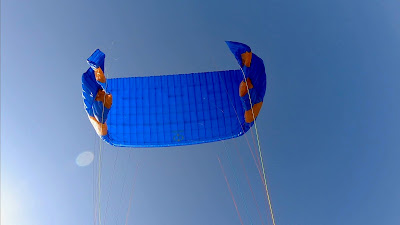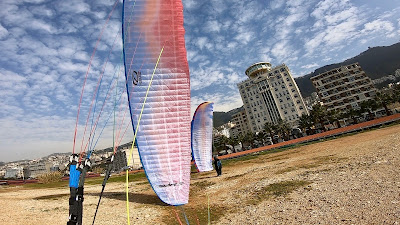Mac Para Eden 7 24 (70-90)
I asked MacPara to purchase that glider like usual. Then I got an email that a demo glider was already sent, and I have to return it afterward!
After lots of delays at our customs office…like usual, the Eden 7 was released. Mac Para wanted the glider back for the Kossen exhibition, but I only flew it once and felt something different and I emailed Macpara that I must purchase that glider as I need more time on it, there was something very interesting! but they replied that they are sorry… and they prefer to get the glider back! I kept the glider for another 3 flying days and…(to be continued…**)
The test:
The Eden 7 is MacPara 2019 high B glider. With an aspect ratio of 6, good mix of thin sheathed unsheathed lines, nice risers with C steering ability, the Eden 7 is a beautiful looking glider with a racy look.
Launching the Eden 7 is super easy for a high B glider. The take off is immediate.
I flew the Eden 7 24 from 85 to 91 all up to discover the best spot at 87 all up. The Eden 7 was flown with a Delight 3 harness and compared with other B or C gliders flying the same harness.
I flew that glider in mixed conditions from weak to turbulent. Despite the aspect ratio of 6, I never felt it was more demanding to fly than any 5.4 aspect ratio B gliders. In fact, I can say that it seems quite easier to fly than most High B gliders with a lower aspect ratio. The movements of the Eden 7 in turbulent air are not really dynamic for the 6 aspect ratio glider.
I’m not saying that it resembles the low B category. It needs a high B pilot, but the Eden 7 felt like a very well balanced high B glider that works well in itself.
There weren’t any unnecessary movements coming from the glider. Just good, well-balanced feedback, that was exactly needed for the high B category. The Eden 7 feels like an educational high B with the exact amount of “relaxed” feedback for the XC pilot.
The authority on the brakes at 87 all up is simply ”amazing”. It is not the most agile high B glider but still very satisfying agility with a short brake travel, precise to place it inside any core, direct to swiftly engage a turn without delay, moderate pressure that kept my hands quite comfortable all the flight.
Those characteristics of handling and brake authority on the Eden 7 quickly won my heart!
I never regretted test flying that EN-B in those good and rare flyable days this year.
I would describe the overall feedback as “polite”. Exactly what should be felt under an XC machine for long flights.
Loading the Eden 7 at 87 all up is very efficient even in weak thermals. This high B is definitely a floater within its category.
In strong cores it also climbs ‘super’ well as the Eden 7 surfs the air forward like a very good high B, and it’s even very competitive with the class above in climb and glide.
Surfing a difficult airmass for a high B is a blessing, as some will bump and pitch back. Not on the Eden 7, as it never kept from surprising me in that matter. It does surf forward and climb like “higher rated gliders”.
The Eden 7 glide at bar similar to the best B’s in that big category with an edge! The edge was found on top speed! It is quite fast for the category, and very usable.
On my Eden 7 size 24 similarly loaded as a Mentor 6 same size (70-90), I was around +1 km/h faster at top speed!
Its also faster than an Alpina 3 S and the glide at trim and at bar was over my expectations, to say the least!
While pushing the bar, the C steering is hard to pull, with a fair efficiency in turbulence.
The trim speed is similar to the Mentor 6, and the Eden 7 has around 15..16 km/h over trim taken at 1000 ASL.
I also flew next to higher rated gliders, just to see the potential of the Eden 7, and I can totally confirm my earlier comments that put the Eden 7 on the highest level!
The ears are stable to a certain pull and reopen fast. Induced asymmetries and holding the A risers down are easy to counter steer with no big loss of altitude.
Frontals make a slight horseshoe but reopen quickly. Wing overs are nice, without any excess of dynamic and energy!
I already updated my B category.
Conclusion:
In this large EN-B category, many manufacturers are really making huge progress to deliver us quite interesting gliders, and it's becoming silly to always write positive reviews, but i surely recommend test flying that one! No dull feel under it, rather than an educational one. It’s like flying a calm higher rated glider with an impressive performance package.
The Eden 7 in size 24 is a high B glider but an easy one to fly for the experienced B pilots, with superb handling and brake authority.
It has a relatively calm and balanced behavior. The overall package of performance is efficient and very usable!
For a high B pilot looking for an excellent creation, the Eden 7 fulfills every need and check every box. It would be very interesting to test flying one at its optimum load.
**- Now to continue my story with Mac Para…I insisted to keep that glider. And I paid for it just because I couldn’t return back such a beautiful piece of a flying machine! and I also needed to keep it as a testing reference for this summer!




































